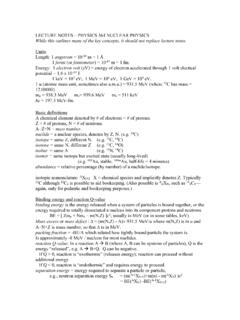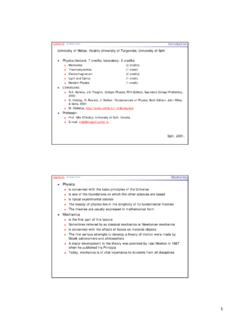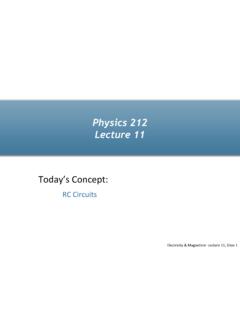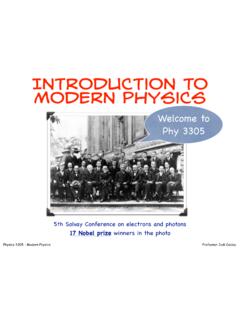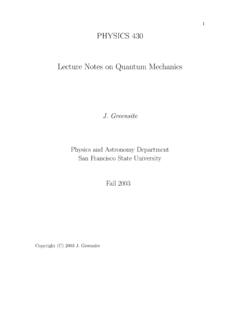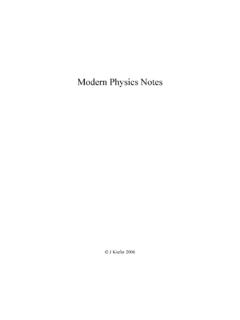Transcription of Lecture 34: Principal Axes of Inertia - University of Arizona
1 Lecture 34: Principal Axes of Inertia We ve spent the last few lectures deriving the general expressions for L and Trotin terms of the Inertia tensor Both expressions would be a great deal simpler if the Inertia tensor was diagonal. That is, if:or Then we could writeijiijII =123000000 III = I2rot,,111222iijjiijjiijjijijiijijiii ji jiLIIITIII ====== We ve already seen that the elements of the Inertia tensor transform under rotations So perhaps we can rotate to a set of axes for which the tensor (for a given rigid body) is diagonal These are called the Principal axesof the body All the rotational problems you did in first-year physics dealt with rotation about a Principal axis that s why the equations looked simpler. If a body is rotating solely about a Principal axis (call it thei axis) then: If we can find a set of Principal axes for a body, we call the three non-zero Inertia tensor elements the Principal momentsof Inertia , or iiiiLII ==LFinding the Principal Moments In general, it s easiest to first determine the Principal moments, and then find the Principal axes We know that if we re rotating about a Principal axis, we have: But the general relation also holds.
2 So,I=LA Principal moment iijjjLI = 111111221332221122223333311322333 LIIIILIIIILIIII ==++==++==++ Rearranging the equations gives: Linear algebra fact: We can consider this as a system of equations for the Such a system has a solution only if the determinant of the coefficients is zero In other words, we need:()()()11112213321122223331132233300 0 IIIIIIIIIIII ++=+ +=++ =i 1112132122233132330 IIIIIIIIIIII = The determinant results in a cubic equation for I The three solutions are the three Principal moments of Inertia for the body (one corresponding to each Principal axis) And this brings us the resolution of the apparent contradiction between freshman-level physics, in which there were three moments of Inertia , and this course, where we needed 6 numbers In the earlier course, only rotations about Principal axes were considered!Finding the Principal Axes Now all that s left to do is find the Principal axes.
3 We do this by solving the system of equations for Using one of the possible values of I call it I1 This will give the direction of the first Principal axis It turns out that we won t be able to find all three components But we can determine the ratio And that s enough to figure out the direction of the first principle axis (in whatever coordinate system we re using) i 123:: Example: Dumbbell Consider the same dumbbell that appeared last Lecture , and define the coordinate system as follows:mm( ,, 0)bb (, , 0)b b 2222222201102202110004002bbmbbb mb == I So the equation we need to solve is: Let s find the Principal axis associated with I= 0:() ()()[]() ()()222110110000221102202200, 2 or 22 IIIIIIIIIIIImb = = = == 121230040 +=+== So the ratio of the angular momentum components in our coordinate system when the object it rotating about the Principal axis with I= 0 is:meaning the axis is defined by the vector:In other words, along the axis of the dumbbell What about the other Principal axes?
4 The axes associated with I = 4mb2are:123::1 :1 : 0 = = xyreeIf an object has an axis of symmetry, that axis isalways a Principal axis12120000 += == There s not much information in those equations! For example, the zcomponent could be anything This means that anytwo axes perpendicular to the axis of the dumbbell can be taken as Principal axes Note that the Principal axes one finds can depend both on the shape of the body andon the point about which it s rotating Look over Examples and in the text They show that one finds different Principal axes for a uniform cube depending on whether it s rotating about a corner or about the center of massWhen Can We Find Principal Axes? We can always write down the cubic equation that one must solve to determine the Principal moments But if we want to interpret these as physically meaningful quantities, the roots of that cubic have to be real Recall that in general, cubics can have two complex roots Fortunately, we re notin the general case here The Inertia tensor is both real and symmetric in particular, it satisfies: Matrices that satisfy this restriction are called Hermitian For such matrices, the Principal moments can always be found, and they are always real (see proof in text)*ijijII=This mathematics will come up again in Quantum MechanicsPrincipal Moments EigenvaluesPrincipal Axes Eigenfunctions


